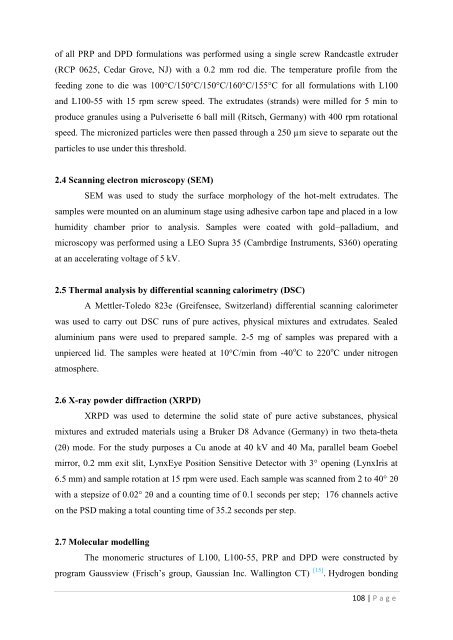Development of hot-melt extrusion as a novel technique for the ...
Development of hot-melt extrusion as a novel technique for the ...
Development of hot-melt extrusion as a novel technique for the ...
Create successful ePaper yourself
Turn your PDF publications into a flip-book with our unique Google optimized e-Paper software.
<strong>of</strong> all PRP and DPD <strong>for</strong>mulations w<strong>as</strong> per<strong>for</strong>med using a single screw Randc<strong>as</strong>tle extruder(RCP 0625, Cedar Grove, NJ) with a 0.2 mm rod die. The temperature pr<strong>of</strong>ile from <strong>the</strong>feeding zone to die w<strong>as</strong> 100°C/150°C/150°C/160°C/155°C <strong>for</strong> all <strong>for</strong>mulations with L100and L100-55 with 15 rpm screw speed. The extrudates (strands) were milled <strong>for</strong> 5 min toproduce granules using a Pulverisette 6 ball mill (Ritsch, Germany) with 400 rpm rotationalspeed. The micronized particles were <strong>the</strong>n p<strong>as</strong>sed through a 250 µm sieve to separate out <strong>the</strong>particles to use under this threshold.2.4 Scanning electron microscopy (SEM)SEM w<strong>as</strong> used to study <strong>the</strong> surface morphology <strong>of</strong> <strong>the</strong> <strong>hot</strong>-<strong>melt</strong> extrudates. Thesamples were mounted on an aluminum stage using adhesive carbon tape and placed in a lowhumidity chamber prior to analysis. Samples were coated with gold–palladium, andmicroscopy w<strong>as</strong> per<strong>for</strong>med using a LEO Supra 35 (Cambrdige Instruments, S360) operatingat an accelerating voltage <strong>of</strong> 5 kV.2.5 Thermal analysis by differential scanning calorimetry (DSC)A Mettler-Toledo 823e (Greifensee, Switzerland) differential scanning calorimeterw<strong>as</strong> used to carry out DSC runs <strong>of</strong> pure actives, physical mixtures and extrudates. Sealedaluminium pans were used to prepared sample. 2-5 mg <strong>of</strong> samples w<strong>as</strong> prepared with aunpierced lid. The samples were heated at 10°C/min from -40 o C to 220 o C under nitrogenatmosphere.2.6 X-ray powder diffraction (XRPD)XRPD w<strong>as</strong> used to determine <strong>the</strong> solid state <strong>of</strong> pure active substances, physicalmixtures and extruded materials using a Bruker D8 Advance (Germany) in two <strong>the</strong>ta-<strong>the</strong>ta(2) mode. For <strong>the</strong> study purposes a Cu anode at 40 kV and 40 Ma, parallel beam Goebelmirror, 0.2 mm exit slit, LynxEye Position Sensitive Detector with 3° opening (LynxIris at6.5 mm) and sample rotation at 15 rpm were used. Each sample w<strong>as</strong> scanned from 2 to 40° 2with a stepsize <strong>of</strong> 0.02° 2 and a counting time <strong>of</strong> 0.1 seconds per step; 176 channels activeon <strong>the</strong> PSD making a total counting time <strong>of</strong> 35.2 seconds per step.2.7 Molecular modellingThe monomeric structures <strong>of</strong> L100, L100-55, PRP and DPD were constructed byprogram Gaussview (Frisch‘s group, Gaussian Inc. Wallington CT) [15] . Hydrogen bonding108 | P a g e
















